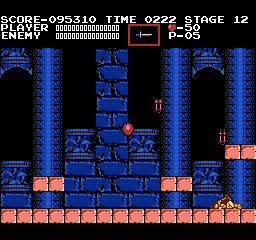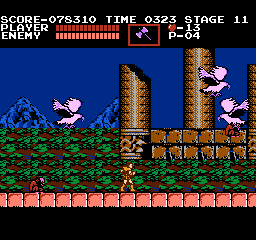Publisher: Konami
Year: 1987
Genre: Platform Adventure
Few names in the video game world are associated with so rich a canonical history as “Belmont,” the surname of the vampire-hunting family from the acclaimed Castlevania series of games, and though the storied background and heroic legacy of the Belmont family has been expounded in the sequels, prequels, interquels and alternate timelines, this is where it all began.
![Castlevania (U) (PRG0) [!]_001](https://www.everynesgame.com/wp-content/uploads/2016/08/Castlevania-U-PRG0-_001-1.png)

Castlevania is about a vampire hunter’s quest to “destroy forever the Curse of the Evil Count,” although, “forever” is something of a subjective concept to the undead. While the expanded universe canon would eventually place Simon as the fourth Belmont to take on Dracula chronologically (so far), the original Nintendo manual is pretty lean on explanation. In fact, Simon’s name isn’t even mentioned in the English language version of the manual, although he is cited in the end credits as “Simon Belmondo” (and, moreover, “Simon Belmont” was circulated widely enough in other media to be well-known).
Gameplay is pretty standard Nintendo-era platform fare. Simon moves with a sort of steadfast plodding dignity, and once he begins on a jumping trajectory, he has no power to change it. When he steps off a platform, he plummets straight down, though he never takes falling damage, save for when he lands in water or falls off the bottom of the screen. Frankly, if one were to judge this game solely on Simon’s platformer credentials, it would definitely not be at the top of the list. His only redeeming quality from a purely platformer perspective is his health bar, which is frequently made irrelevant as plummeting off the bottom of the screen is the most common cause of death and kills you instantly.

While the last couple of paragraphs might have sounded over-critical, this game is a genre-defining classic of the Nintendo Hard era for a reason – Castlevania manages throughout to balance being brutally unforgiving of platforming mistakes with genuinely enjoyable gameplay. While even experienced players will find themselves shaking their fists at the erratically appearing but steadfastly patterened medusa heads, the sheer sense of pride and satisfaction that comes from flawlessly navigating through a grouping of the damnable things is undeniable. Likewise, the boss fights can be unbelievably tough, especially if you’re left with an un-upgraded whip and the wrong secondary weapon, but with proper preparation, experimentation and skill it is quite feasible to finish them all without so much as a scratch.
For me, one of the best things about this game is the opportunity to look back and reminisce on a long-running game series – to remember the humble origins of the ever-expanding Castlevania library of games. Nearly every gameplay element from Castlevania has been preserved and refined in every subsequent game in the series. The medusa heads, the skeletons, the jumping hunchbacks and knights all appear in the later titles in almost exactly the same form, though sometimes with small changes (the knife-throwing hunchbacks and paralyzing medusa heads found in much later titles, for example). The sub-weapons have been carried over, some more-or-less the same, some completely different. Even the levels and layout of the castle appear in the sequels.

John’s Rating: 4.5 out of 5.0. It isn’t an exaggeration to say that this may have been one of the most influential games of all time and for good reason, but it’s also fair to say that the gameplay principles could stand some polishing, even for a game from the NES era.